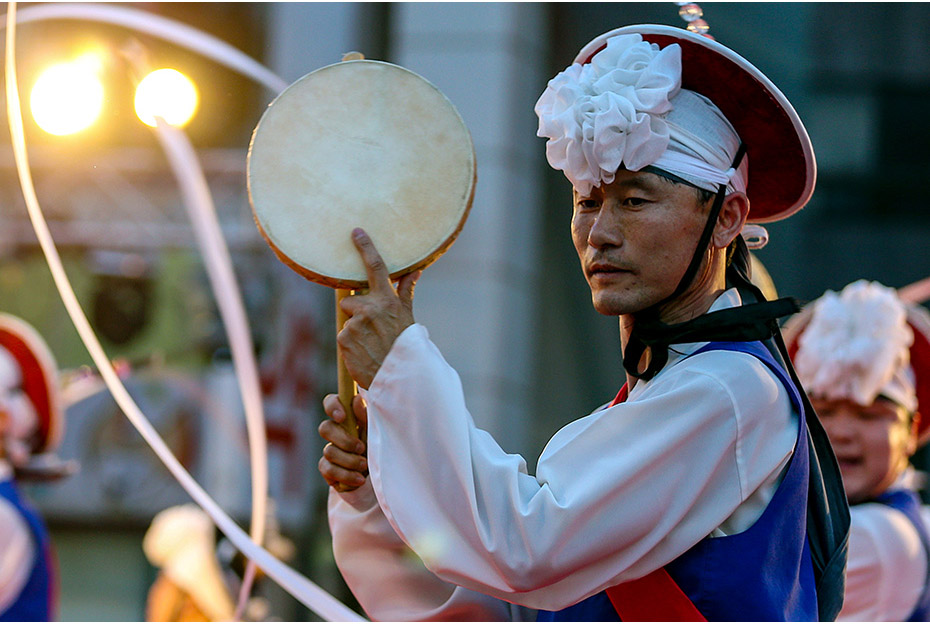Doctor of Literature, Gangneung Dano Center
The Gangneung Danoje Festival has maintained typical elements of ancient festivals that were held in May (seedtime) and in October (harvest time) during the Samhan period (around 300 CE). In the fifth lunar month, which includes Dano day, local people perform rituals for driving away evil spirits and welcoming the fortune and participate in traditional games and activities. The main deities of the festival are the mountain god, Kim Yusin, who was the general of Shilla and the United Three Kingdoms, and the royal tutor tutelary deity, Beomil, who was a Shilla monk. The first documented record of Dano folklore appears in the Samguksagi (A History of the Three Kingdoms). Other records indicate that Dano has commonly been referred to as ‘Suri’ in local dialects.
The Gangneung Danoje Festival is a collective community festival. Although Dano and similar holidays based on agricultural cycles originate from China and are popular throughout Asia, the Gangneung Danoje Festival differs from other Dano-like celebrations as it has evolved as a comprehensive festival that, while based on shamanism, embraces universal religions and has its roots from deep within Korean traditional culture as well as local agricultural, fishing, and forestry cultures. Because of this widespread scope, the Gangneung Danoje Festival was designated as a Korean Important Intangible Cultural Asset on 16 January 1967 and was proclaimed as a Masterpiece of the Oral and Intangible Heritage of Humanity by UNESCO in 2005.
The period of the festival is fixed by the lunar calendar. In the past, beginning with the brewing of the sacred liquor on the twentieth day of the third month, the Gangneung Danoje Festival was held for more than fifty days, showing the cultural capacity of Gangneung. Today’s festival starts with the brewing of the sacred liquor on the fifth day of the fourth month, and the rituals honouring the mountain god are performed on the fifteenth day of the fourth month, and the main events are held for eight days centred on Dano day.
The 2012 Gangneung Danoje Festival began on 25 May with the brewing of the sacred liquor, and the ritual for the tutelary deity was held on 4 June. The main events were held from 20 to 27 June. On 22 June, participants and visitors of the festival watched the splendidly organized and choreographed Deity Welcoming Parade.
One of the interesting elements of Danoje Festival is that there are no professional agencies involved with organizing the magnificent events. The Society for the Preservation of the Gangneung Danoje Festival organizes designated cultural asset events such as the rituals, the Gwanno Mask Drama, and other local cultural assets, such as Gangneung Farmer’s Music, Haksan Odokddegi (farming song), and Sacheon Hapyeong Danpgyonori (farming game). In addition, the Gangneung Danoje Festival Committee organizes folklore events (swings, wrestling, archery, and Tuho) and various domestic and international performances, experience programs, and celebration events. The events of the festival have long been organized by local people, and the wholesomeness of these events offers an unforgettable environment for family and friends to bond with one another.
Gangneung is home to several intangible cultural heritage elements designated on UNESCO ICH lists. And for this reason, in 2007, the city government developed a long-term comprehensive plan to merge world intangible cultural heritage with the Gangneung Danoje Festival. To implement this plan, Gangneung has promoted the Creative City of Dano Culture project since 2008. The project includes infusing Dano aesthetics within public spaces, transmitting the festival across generations, developing Dano culture, making Gangneung Dano communities, and publicizing Dano culture. In addition to this project, the city is also seeking to pursue tourism-oriented development of the Gangneung Danoje Festival.
In 2004, Gangneung adopted the initiative of the Inter-City Intangible Cultural Cooperation Network (ICCN), an international organization of local governments for the safeguarding movement of local intangible cultural heritage.
Taking the opportunity of Gangneung Danoje Festival’s inscription on the UNESCO Representative List, the city was approved as the secretariat, and the Gangneung mayor was elected as the representative of ICCN during its meeting in Egypt in 2008. During the ICCN meeting in the Czech Republic in 2009, it was decided that there would be a joint festival held in Gangneung from 19 to 28 October 2012. The aim of the festival will be to promote intangible cultural heritage safeguarding while harmonizing diversity and creativity and encouraging the participation of younger generations, cultural organizations, and experts.
Under the theme, ‘The Value of Intangible Cultural Heritage: Discovered in the City,’ the festival will show residents and international visitors the diversity and creativity of intangible cultural heritage through performances from fifty-six groups from eighteen countries. The festival will also be composed of exhibitions (Korean intangible cultural heritage exhibitions and human culture exhibitions), experiences (intangible cultural heritage experiences), and international meetings.
The Gangneung city government and host organizations of the Gangneung Danoje Festival have been closely cooperating with each other to safeguard intangible cultural heritage and to facilitate sustainable development locally. The Society for the Preservation of the Gangneung Danoje Festival and the Gangneung Danoje Festival Committee are making their utmost effort to promote education, performances, and cultural exchanges.
The Gangneung city government, recognizing that intangible cultural heritage is an important resource for sustainable development, supports two host organizations and is moving towards revitalizing the downtown are through the Gangneung Danoje Festival and developing tourism industries based on traditional festivals.







